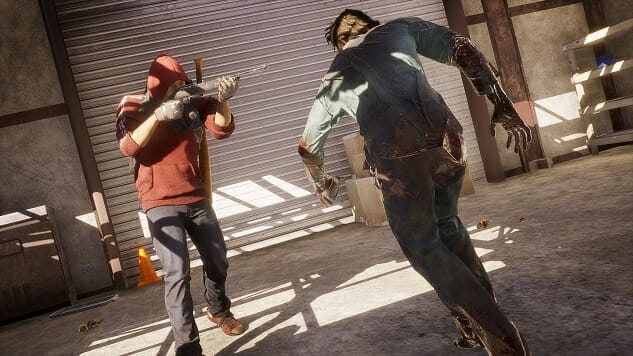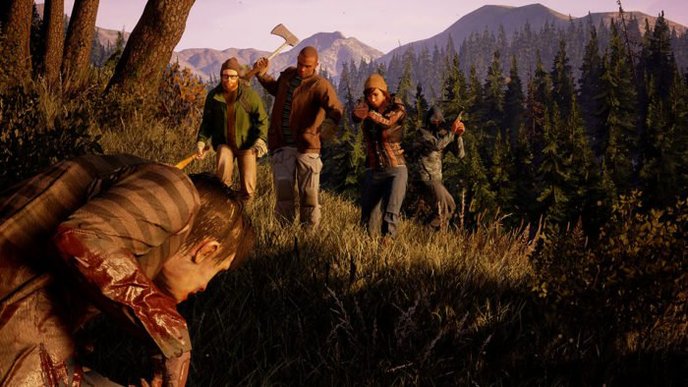
The zombie apocalypse won’t go away. The rotting corpse of The Walking Dead television show and the long shadow cast by Max Brooks’s Zombie Survival Guide seem to have fundamentally warped our media culture toward , well, walking and rotting corpses. We can’t shake it, and in most instances this fixation on zombies, the end of the world, and those who live on afterward to fight for the existence on a torn-down planet are boring and trite. 2013’s State of Decay released in a more lively zombie time, and it was an important game for me. Story-light, focused on looting and basic survival, and punishing when it came to failure, State of Decay was one of the most interesting and rewarding games I had played at that point. Now we have the sequel, State of Decay 2. It needs to crawl back in that grave.
I can clearly remember the exact location where I lost my first survivor in State of Decay. I was on the eastern side of the map traveling from one side of the region to the other. The winding, rocky canyon wasn’t normally a place where I would have trouble in a car, but the stark blackness of the night and my impatience about returning to my home got me into trouble. I swerved, my car flipped over on its top, and my survivor had to hop out of the car to make his way home.
Normally that wouldn’t be a problem. I slowly started sneaking my way toward home, knowing that if I moved quietly enough and sprinted at the right moments that I could make it back after some trials and tribulations. Sadly, my survivor met a feral between the crash and home. A ravenous, violent zombie, the feral made short work of my survivor, leaving him dead on the asphalt.
I can remember that so vividly because that’s the kind of encounter that State of Decay delivered constantly. You put so much time into your survivors and had so many close calls that a loss, a real loss, was devastating. You felt it when you took an L.
State of Decay 2 aims to be a slight upgrade from the first game. Mechanically, it is basically an expansion pack that expands what you can do and how you can interact with the same kinds of explorable houses, drivable cars, and hordes of zombies that populated the world of the first game. To be clear, I think that this is a good thing; State of Decay is not a thing that needs to be reinvented. An expansion is exactly what I was looking for. I wanted more opportunities and new kinds of rewards, both narratively and in relation to what the game asked of me, and the sequel does that.
There is an increased breadth of experience related to the narrative in State of Decay 2. There are a lot more factions in the sequel, and they all want to interact with you in different ways. You do tasks for them, or fight them, and in those ways you craft your own story about your survivors and what they do. It is not full of Big Narrative Moments crafted by a crack team of writers, but there are a lot of different interactions that let you tell your own story out of the contexts that you find yourself in. For me, this is the strength of this series. I don’t want a linear narrative. I want a sandbox of beats that I craft into a story for myself. For the most part, this game is successful at creating a range of moments where those interactions can happen. I have to decide if I want to help the mechanics take their garage back, and how well I perform that action has a bearing on my world. When I accidentally let the apprentice die, leaving the car repair to some old masters without a future, I had to stop playing for a little while.
However, “breadth” is not something that State of Decay 2 goes for in most instances. Instead, it tries to fill out the world with depth. Everything gets an upgrade path: your survivors upgrade their stats and skills; each construction you make in your base is upgradeable and augmentable with modifications; your vehicles can be armored; you can make your harvests of materials more efficient. The developers of State of Decay 2 seem to think that they are making some kind of combination of a crafting game, an RPG, and a survival simulation, and the depth of the different systems seems to be in service of chasing all of those goals.
Ultimately, I am into the State of Decay games because they make me invested in characters and the choices those characters make in a hard world. While State of Decay 2 has made some improvements to the systems that allow me to do those things, far more development time went into management requirements that feel more like chores than they do rewarding hooks for gameplay to hang on.
The chore-like nature of the game is even more striking when you take multiplayer into account. The first State of Decay lacked multiplayer, and the major promise of the sequel was that it would allow you to do all the base building and zombie killing with your friends. And, good news, you can! And it mostly works, although I consistently had issues like not being able to deposit goods or access inventory features when I was in another player’s game. However, the multiplayer grinds to an absolute halt when a player needs to stop for fifteen minutes to check out all of the upgrades for their base or loot basic items for base survival. Since multiplayer hinges on going to a player’s world and hanging out with them, that player still needs to do all of the normal chores they would do in their game. Some of the time you spend in multiplayer does not feel meaningful, and that’s a tragedy given how fun it is to clear out infestations, help allies, and hunt down special zombies with your friends.
Overall, I have some mixed feelings about State of Decay 2. It is a game that feels less focused than its predecessor despite making strong moves to deepen the experience in every realm. Focusing in on the details somehow made the game lose something; the steps the game took forward cost something fundamental and core to the experience.
State of Decay 2 was developed by Undead Labs and published by Microsoft. Our review is based on the Xbox One version. It is also available for PC.
Cameron Kunzelman tweets at @ckunzelman and writes about games at thiscageisworms.com. His latest game, Epanalepsis, is available on Steam.
